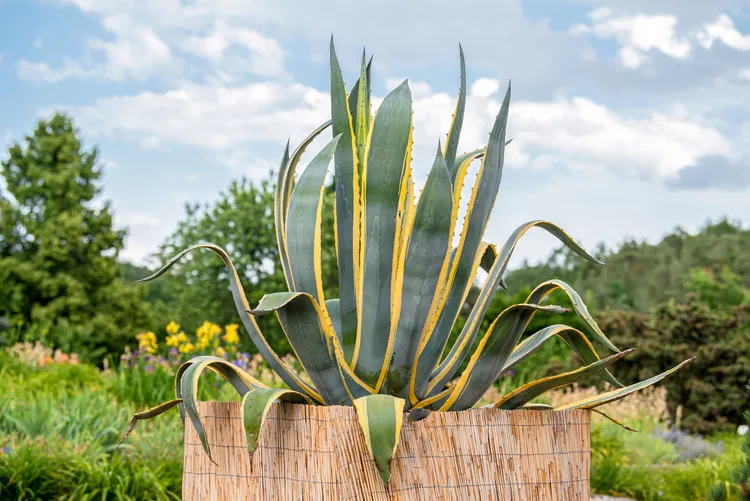An impressive succulent exceeding ordinary proportions, the century plant stands out as an aesthetically captivating member of the agave species. Its potential dimensions reach up to ten feet in width and six feet in height, featuring succulent, gracefully arching leaves that come in shades of grey-green or exhibit variegated patterns. For safeguarding purposes, these leaves terminate in pointed spines, serving as a deterrent against potential disturbances from pets or individuals. It’s worth noting that the plant’s sap possesses mildly toxic properties.
Despite its colloquial name as the American aloe, this plant’s nomenclature is somewhat misleading. The previous belief that it required a century to flower has been dispelled, and we currently understand that its blooming phase occurs after a span of two to three decades during which it accumulates energy to produce a solitary stalk. This towering stem culminates in an inflorescence of petite yellow blossoms. Operating as a monocarpic species, the flowering spectacle signifies the plant’s final act before it reaches the end of its life cycle.
| Common Name | Century plant, American aloe, maguey |
| Botanical Name | Agave americana |
| Family | Asparagaceae |
| Plant Type | Succulent |
| Mature Size | Three to six feet tall, six to ten feet wide |
| Sun Exposure | Full |
| Soil Type | Sandy, well-drained |
| Soil pH | Acidic, neutral, alkaline |
| Bloom Time | Summer (rarely blooms) |
| Flower Color | Yellow |
| Hardiness Zones | 8-11, USDA |
| Native Area | Texas and Mexico |
| Toxicity | Toxic to people, toxic to pets |
Century Plant Care: A Guide to Growing and Caring for Agave Americana
Cultivating and tending to a century plant demands a hands-off approach and patience. These impressive agave plants thrive in well-draining soil and thrive with intermittent watering that adapts to local climate conditions. While waiting for a decade, and often even longer, for the majestic flower stalk to emerge, anticipate a bountiful production of offshoots. These offshoots can either form a substantial colony or be transplanted to new locations. However, remain vigilant against the threat of agave snout weevils, as their presence can lead to irreparable damage to the plant.
Optimal Light Conditions:
Just like other agave species, century plants flourish under full sun exposure. Therefore, select a planting site that receives a minimum of six to eight hours of sunlight daily. Nevertheless, if your location doesn’t offer ideal sun exposure, growing these plants in light shade is also possible.
Choosing the Right Soil:
Century plants thrive in dry, sandy soil. Although they can tolerate various soil types, including clay, well-draining soil is a non-negotiable requirement. Overly moist soil can lead to root rot, so be cautious.
Watering Strategy:
The fleshy, elongated leaves of the century plant are adept at storing water during dry spells, so avoid overwatering. However, during the spring and summer growing season, regular watering is appreciated. Ensure deep watering sessions followed by thorough drying of the soil between intervals, which can range from a week to a month based on the prevailing climate conditions.
Temperature and Humidity Preferences:
Originating from Mexico and Texas, century plants reveal their preference for warm temperatures with low humidity levels. The plant can endure temperatures down to about 20 degrees Fahrenheit but is susceptible to frost damage.
Minimal Fertilization:
Typically, century plants do not require fertilization. They thrive in nutrient-scarce sandy soil. Moreover, since they die after blooming, feeding them with fertilizer might expedite their life cycle but at the cost of longevity.
Diverse Century Plant Varieties:
- ‘Marginata’: Also referred to as variegated century plant, this variant boasts cream-to-yellow margins along leaf edges, adding visual allure.
- ‘Mediopicta alba’: A slightly smaller cultivar with gray-green leaf margins and a central stripe of creamy-white. It matures to a height of three to four feet with a spread of four to six feet.
- ‘Mediopicta aurea’: Similar to other mediopicta varieties of Agave americana, this cultivar attains a height and width of six feet. Its variegated leaves feature a vibrant yellow central stripe, and it tends to tolerate light shade better than certain other agave types.
Propagating Century Plants:
As with other agave species, the most straightforward method of propagation is through offsets or pups. These identical clones of the parent plant can be easily separated and planted individually. A small trowel can be handy, and gloves offer protection against spines. Follow these steps for successful propagation:
- Protect your hands and arms.
- Locate a pup at the base of the parent plant.
- Use a trowel to gently separate the pup from the parent plant and soil.
- Preserve a portion of the stem and root bundle attached to the pup.
- Plant the pup in a well-draining soil container or garden site.
Cultivating Century Plants from Seeds:
Growing century plants from seeds is uncommon, given that these plants only flower once in their lifetime, typically after several decades of growth. The more common approach to propagation is through offshoots, which the plant regularly produces.
Potting and Repotting Tips:
While century plants can be container-grown, remember that they can become quite large. Some gardeners prefer potting them until their size necessitates planting in a permanent ground location. For container growth, opt for a large pot with well-draining soil composed of materials like compost, potting soil, gravel, or sand. Repotting every other year is generally sufficient.
Winter Care:
Century plants are vulnerable to frost and should be moved indoors to survive winter in areas outside their growing zones. Providing protection from the elements, such as placing them near large rocks for added heat retention or covering with a cotton sheet during low overnight temperatures, can help safeguard the plants.
Encouraging Century Plant Bloom:
The most challenging aspect of cultivating a century plant is the waiting game. It often takes two to three decades for these plants to send up a single towering branched flower stalk, sometimes exceeding 20 feet in height. While accelerated blooming can occur, the norm is a one-time bloom, marking the end of the plant’s life cycle. However, the colony of offshoots left behind will continue to flourish.
Addressing Common Issues:
Century plants are generally robust, provided the right growing conditions are met. Yet, excessive moisture can lead to wilted or discolored leaves due to root rot. For such cases, examine the roots, trim away damaged parts, and treat with copper fungicide. Agave snout weevils pose a threat, causing weakening and decay. Preventive measures include regular applications of neem oil or other insecticides.
FAQ
- Do century plants live for 100 years?
No. Despite the name, these plants have a lifespan of 25 to 30 years on average. - When does a century plant bloom?
A century plant will bloom once in its lifetime, usually between 25 and 30 years. Well-fertilized plants may bloom as soon as ten years, but most people avoid speeding up the blooming process, because the plant dies soon after blooming. - Are century plants easy to take care of?
These plants don’t require regular maintenance and will grow with little hands-on care. It is important that they have well-draining soil and don’t receive too much moisture.
Ready to Cultivate Stunning Century Plants? Let My Home Wizard Be Your Green Thumb Partner!
Discover the art of growing and caring for magnificent century plants with the expertise of My Home Wizard.
Our team of skilled professionals can guide you through every step of nurturing these impressive succulents, ensuring they thrive in your landscape.
From selecting the perfect spot for optimal sunlight to maintaining the right watering regimen, we’ll help you create a flourishing haven of agave Americana.
Your century plants deserve the best care, and we’re here to provide it!
Ready to Restore Your White Walls to Perfection?
If your white walls need a professional touch, My Home Wizard is here to help.
Our skilled team uses safe and effective techniques to ensure your walls remain flawless and stunning.
Elevate the beauty of your home with our white wall cleaning services.
Contact us at My Home Wizard to schedule an appointment and experience the magic of spotless walls.







